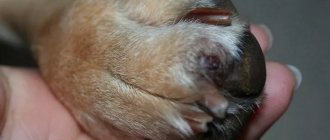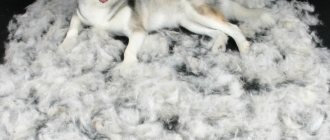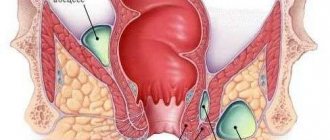Food hypersensitivity
The most common food allergy is called food intolerance. Red, scaly spots appear on the Pekingese's skin The dog becomes restless, spins around, rubs against the floor covering, scratches behind the ear, and eyes water. The reason is the wrong choice of nutrition. Pekingese with weakened immune systems are especially vulnerable. Before feeding your Pekingese puppy a new food, you need to determine if he is allergic to this product. Allergy is a reaction to foods consumed such as:
- Dry food of poor quality. Low-quality ingredients are used in its production. Bone meal is replaced with feather meal, chemical dyes and flavor enhancers are present.
- Chicken meat. Modern poultry farms use various food additives and antibiotics. Chicken eggs also undergo special processing. These substances, accumulating in poultry meat, cause allergies when consumed.
- Beef and pork produced on an industrial scale are “stuffed” with growth hormones and antibiotics.
- Soybeans and corn are genetically modified products.
- Store-bought dairy products contain preservatives, stabilizers, etc. In addition, an adult dog does not digest lactose well.
- Vegetables and fruits, especially imported ones, contain pesticides that cause cancer.
Such products are harmful not only to dogs, but also to humans. Gradually accumulating in the body, they provoke allergic dermatoses.
Separately, drug-induced dermatitis can be distinguished. Allergies to medications are quite common in Pekingese. The owner must know which ones, so that when prescribing treatment, he can warn the doctor about this.
Skin diseases
The culprits of your pet's itchy skin are often fungi and bacteria. As a rule, redness or blackening appears in the combed areas, and the hair begins to fall out. Bald spots form. Most often, dogs are diagnosed with lichen, mycosis and various dermatoses.
Small brachycephalic breeds are susceptible to skin fold dermatitis. This group includes French bulldogs, Pekingese and pugs. More often the disease occurs in the folds of the lower lip.
Microcracks appear in the affected areas, where food debris or saliva enters, creating an ideal environment for bacterial growth. The disease is accompanied by a strong unpleasant odor. Therefore, if your Pekingese or Pug itches, and the itching is accompanied by a stench, you should immediately contact a veterinary clinic for diagnosis.
Important! To prevent dermatitis in bulldogs and pugs, wipe the skin folds with a damp cloth after each meal.
Parasitic dermatitis
Allergic dermatitis can be caused by fleas. From the name it is clear that the cause of the disease is fleas. With flea dermatitis, otitis externa often occurs, affecting the auricle and middle ear. Externally, it manifests itself in the form of purulent discharge; touching the ear can be painful. Parasitic dermatitis is caused by the presence of parasites in the body of the Pekingese. Anal itching also appears when the paraanal glands become inflamed. The inflammatory process can occur when consuming too much meat and soft foods and lacking fiber.
Allergy
Allergies in dogs
You can determine the presence of an allergic reaction by external signs. Red spots, rashes, inflammation, and swelling appear on the skin. At an advanced stage, hair falls out, additional scratches, abrasions, and scratches appear. After the addition of a secondary infection, ulcers, weeping wounds, and suppuration form.
There are many causes of allergies. To clarify the situation, it is necessary to recall the events of the past 14 days. The following can provoke an allergic reaction:
- Medicines. Especially with repeated or long-term use. Often the dog itches after receiving flea drops. Mild signs of allergies disappear on their own within a few days or require special treatment.
- Products. You need to pay attention to new dishes that were offered to the pet or an overabundance of something usual for him: dog food.
- Worms. One of the signs of the presence of parasites in the body is an allergic reaction on the skin, accompanied by severe itching. You need to pay attention to additional symptoms - lack of appetite or brutal demands for food, vomiting, stool disturbances, restless sleep.
- Fabric, hygiene products. A new rug or clothes for a dog can provoke a severe allergy. You should also pay attention to a new shampoo, or any cosmetic product for a dog that has been tested recently. The skin may itch after using antibacterial wipes or eau de toilette.
Malassezia dermatitis
If your Pekingese constantly itches and unpleasant , but there are no fleas or parasites , it means he has an infectious disease.
Malassezia dermatitis or Malassezia in the Pekingese is a fungal disease caused by colonies of the Malassezia species. The presence of these fungi in the normal state is natural; an infection is caused by an increased number of them. The Pekingese develops an unpleasant yeasty , rancid, moldy odor. Clinically, the disease manifests itself in the form of itching, peeling, and hyperpigmentation of the skin. The most commonly affected areas are the ears, lips, armpits, feet, and gray spots are visible on the face . There is noticeable brown discoloration between the toes and at the base of the claws, and the claws become discolored. These changes are typical of Malassezia infection.
An attentive owner will definitely notice changes in the mood and behavior of his pet. If your dog has lost its appetite, is constantly itching , looks lethargic, and its skin and coat have taken on an unhealthy appearance, then you should immediately consult a doctor. Only a veterinarian can determine the disease and prescribe treatment for a Pekingese. Unprofessional treatment will worsen the problem, and the pet may even die.
Treatment of stress, skin diseases and greasy tail
As for stress, veterinarians recommend treatment as quickly as possible, otherwise, prolonged neurosis can lead to the development of phobias. To begin with, increase physical activity or spend more time walking the dog. It is preferable if the walking area is quiet (forest, park area).
You can cheer up your dog by buying him a new toy or introducing him to your neighbor’s (peace-loving) dog.
Sedatives are given to dogs in extreme cases. The most popular and safest are Fitex based on glycerin (1 drop per 1 kg of weight) and Stop-Stress. The drugs relieve anxiety and affect psychogenic behavioral disorders. Only a veterinarian should prescribe such medications, as there are contraindications.
Tablets and drops for dogs Stop-Stress
If the cause is a bacterial or fungal infection, the doctor will prescribe antibiotics with an extended mechanism of action or antifungal agents.
Treatment for greasy tail begins with treating the skin at the base of the tail. Hydrogen peroxide or another antiseptic is applied to the inflamed areas. A sterile gauze swab is placed on top. If necessary, the doctor will prescribe antibiotic ointments. The bandage is changed once a week.
A dog may itch and bite itself for a variety of reasons. To prevent complications, you should immediately show your pet to a veterinarian.
The scientific term is hyperfunction of the sebaceous glands. It occurs more often in cats, but dogs are no exception. The placement of the sebaceous glands resembles a black rosary around the base of the tail, sometimes on its upper surface. Dark spots, matted fur, the formation of oily seborrhea, painful itching are signs of pathology.
The animal feels severe discomfort:
- tries to chew the tail;
- spinning on his butt;
- licks the affected areas.
All these manipulations can injure the tail, causing baldness. To save your pet, specialized products are used, often shampoos. They regulate the functions of the exocrine glands.
Itching in dogs, or why a dog itches
If the dog itches a lot, most owners assume that the culprit is fleas - small blood-sucking brown or black insects that, in addition to itching, bring their pets a lot of other inconveniences in the form of anemia, skin inflammation, restless sleep and exhaustion.
But the reason for a pet’s constant scratching is not always due to the presence of fleas on its body. Itching can also be caused by other bloodsuckers, and even some diseases of the internal organs. In this article we will try to figure out why a dog itches if it doesn’t have fleas.
, what are the reasons for such a misfortune.
The main reason is mites
The most common cause of itching in pets is flea bites. However, not only they can lead to itching, but also other parasites - mites.
Their bites pose a serious danger to the dog's health. It is sometimes quite difficult to notice them with the naked eye due to their microscopic size. The most common types of ticks found on dogs are:
- Subcutaneous mite . Leads to the development of the disease demodicosis. The parasite feeds on keratinized skin scales. It lives on the epidermal surface for a long time. When immunity is lost, the mite penetrates deeply into the skin and leads to intense itching. Female parasites lay eggs in the hair follicle. This causes inflammation and the appearance of a red rash, sometimes purulent. The symptom appears mainly on the animal’s face – around the mouth, nose, and organs of vision. The fur in these areas begins to fall out.
Traces of subcutaneous ticks in a dog
This is what an ear mite looks like
Ixodid tick is one of the most dangerous and terrible parasites
Dog infected with scabies mite
Important! It is known that ticks are carriers of deadly infectious diseases.
Signs of itching in dogs
So, if a dog itches, then it is tormented, this is obvious. In addition to the characteristic movements of the hind paw and constant biting, an itchy animal may also frantically lick its body, whine pitifully, sleep poorly, lose interest in games, treats and favorite food (this will affect its weight), and constantly rub against the carpet or pieces of furniture. As a rule, with severe itching, the dog’s skin looks reddened, inflamed, and the condition of the coat leaves much to be desired, up to the appearance of completely hairless areas.
Dog itching
It can be either localized, for example, when a dog’s ears itch, or generalized, when the whole body itches. Sometimes you can determine the cause of scratching by simply observing your pet. For example, itching in the ears is possibly otodectosis, and if the stomach itches, it is an allergy or dermatitis. However, you should not diagnose your dog yourself; it is better to consult a specialist.
Stressful state
During the examination, the doctor assesses the condition of the dog’s coat and skin and prescribes treatment. The pet owner must remember about preventive vaccinations and give injections on time.
There is no easy way to cure hair loss in dogs. The root cause will be identified by the doctor based on the diagnosis; this cannot be done at home. It is better to consult a specialist; there are many concomitant diseases.
Tests are taken. A scraping made with a special tape will determine the presence of fungal and infectious diseases.
If a hormonal imbalance is detected, the doctor will prescribe hormonal medications. They will help restore hormonal levels, the hair will stop falling out and will be restored.
We invite you to familiarize yourself with: Bactrian Bactrian camel
The cause of hair loss is parasites. In this case, the dog will be prescribed drops. They will destroy external parasites. The doctor will prescribe medications to take orally to help get rid of helminths. Complex action drugs have been developed that get rid of all parasites at once. An advanced case requires taking antibiotics.
Dog hair serves as protection against environmental factors. It will show the dog's health status. Therefore, hair loss has several causes, including diet, keeping a pet, and various types of diseases.
If you follow the rules, examine your dog on time and consult a doctor, hair loss can be avoided. The main thing is not to self-medicate.
Stress in a dog can also lead to the animal constantly itching. Four-legged animals suffer from neuroses much more severely than humans. Prolonged stress leads not only to itching, but also biting, restlessness, increased licking of certain parts of the body, and even hair loss.
Does the dog bite its tail? Maybe she's stressed
The dog can also:
- rushes around the apartment in circles for no reason;
- do not listen to the owner’s commands;
- whine, bark and howl;
- bite the tail;
- chew everything that gets in her way;
- dig while in the apartment;
- eats all the time (cannot get enough) or, on the contrary, refuses to eat;
- drooling, breathing heavily, going to the toilet frequently;
- hide in a corner, tremble;
- don't sleep.
What to do if your dog itches all the time
If your pet scratches itself once or twice a day, then there is no reason to worry. And when the itching literally exhausts the animal? If your dog has lost peace and sleep, constantly scratching and licking his body, it’s time to take action. To relieve skin inflammation, animals are given corticosteroids (Cortisone, Dexamethasone, etc.), and antihistamines (Tavegil, Suprastin, etc.) to eliminate itching. Wounds on the body are treated with antiseptic drugs (Levomekol, Zinc ointment, etc.). If you are sure that the scratch is caused by the presence of parasites, insectoacaricidal agents are used (Advocate, BARS Forte, etc.).
Itching and skin diseases
There are many diseases that lead to intense scratching in dogs. The most common ones are:
- Sebaceous tail (dysfunction of the sebaceous glands). Itching is observed in the anus and sacrum, accompanied by the appearance of blackheads. The animal constantly reaches out to these places and licks them. The itching subsides for a while, but then returns, causing the dog to worry. The progressive stage leads to baldness in the area of the base of the tail and back. Acne can spread to the ears and other areas of the body.
- Endometritis . An inflammatory disease that develops in the uterus. At the same time, the dog constantly licks itself and drinks a lot, and its body temperature is increased. In the advanced stage, there is loss of appetite and hair loss.
- Fungal diseases. Typically, dogs are diagnosed with microsporia, which is caused by exposure to the fungus Microsporum canis. Only a veterinarian can detect pathology under an ultraviolet lamp. Areas affected by the fungus are highlighted in green.
Fungal diseases on a dog's paw
Staphylococcal lesions on the dog's face
Attention! Long exposure to sunlight can also lead to itching in dogs. Most often this applies to pets with short hair. Sunburn leads to severe itching. At the same time, the dog tries to scratch the burned areas. Upon contact with them, the pet begins to howl in pain. Redness, blistering, and increased body temperature may occur.
Read more about the causes of itching in dogs here:
Video - Itching in dogs
Causes and signs of itching in dogs: exoparasites, allergies, skin diseases
Constant itching in pets often indicates the presence of fleas. However, there are situations when there are no parasites, but dogs or cats are constantly itching. This symptom indicates the course of skin diseases. Your pet may also itch due to stress. Moreover, an external examination of the problem area does not always reveal other symptoms. Against the background of stress and skin diseases, the skin often retains its natural color, which is not typical for fleas, whose bites leave red spots on the body.
Veterinarians identify several causes of discomfort in pets. When a dog itches, but there are no fleas and the skin is clean, this may indicate increased sensitivity to external irritants, systemic pathologies or dermatoses. In each of these cases, the intervention of a veterinarian will be required.
Ectoparasites in dogs: mites, lice, lice
One of the most dangerous ectoparasites, mites, appear on external organs and body surfaces of both animals and owners. In the process of evolution, they acquired microscopic sizes, which makes them practically invisible and invulnerable. There are countless species, but the following insects are most often found in dogs.
- The Ixodid tick causes encephalitis, borreliosis, piroplasmosis, ehrlichiosis, etc. It is highly not recommended to treat diseases on your own; your pet should be taken to a veterinarian. Due to the salivary glands secreted by the parasite, the dog begins to experience severe itching and inflamed scratches appear near the head, neck, and ears. Just like a flea bite, an allergic reaction occurs and contributes to the development of a rash.
- The gamas parasite, as a “transit passenger,” can use the animal’s torso. Its “clients”: small rodents or domestic and wild birds. If they are not nearby, then the dog becomes a victim.
- Subcutaneous mites provoke the disease demodicosis. They reside in the epidermis for a long time, using horny skin scales. When the pet's health weakens, mites make their way inside and leave eggs in the hair follicle. Afterwards, redness, even purulent form, forms. On lesions in the nose, mouth or eyes, all the hair falls out. If you don't put it on on time, i.e. Before visiting the veterinarian, a special collar, scratching will be severe.
- Scabies arachnids can penetrate deep into the skin and cause aggressive itching, especially at night. Scabies can bring your pet to stress; it practically tears the skin due to severe discomfort.
- The ear mite got its name because it tries to get to the ear canal, where it feeds on wax and secretions of the sebaceous glands. On the way to the “destination”, it parasitizes any part of the torso, where it gnaws the skin to reach the lymph. When present, pets shake and scratch their ears intensely.
No less destructive for the body of an animal of any age are lice and lice-eaters, which feed on fluff and scales of the skin. Their points of dislocation are on the neck, head, and spine. Eggs resembling white grains can be laid in the wool. Signs of their presence are dull, falling out hair, rashes.
The tricky part is when the dog itches, but no fleas or ectoparasites are found during a visual inspection. Cheyletiosis provokes an insect that can only be seen with a magnifying glass. The disease resembles dandruff, but when you zoom in, you can see the movement of the scales, this is especially noticeable in dark-colored animals. Only a veterinarian can get rid of cheyletiosis. For an accurate diagnosis, a scraping is made and laboratory analysis is performed.
Self-medication will not help with any disease, but in order to prevent the appearance of ectoparasites, it is better to take preventive measures:
- purchase a protective collar, for example, Kiltix, Foresto;
- treat your pet with medicinal sprays (Bars, Bolfo, Frontline) or drops (Serco, Advantis, Ralph Club).
Signs of itching in dogs
If a dog is itching a lot, most breeders attribute this situation to fleas. When a Spitz (pug, Pekingese and other pets) bites its body or constantly performs characteristic movements with its hind legs, it is recommended to inspect the fur: there may be blood-sucking parasites on the skin. But if there are no pests, and the puppy is itching, you need to pay attention to the animal’s behavior. Intense itching, characteristic of some pathologies, provokes the following:
In cases where the dog itches all the time, even in the absence of fleas, the skin on certain parts of the body becomes bright red, and the hair falls out.
Another important sign of itching is the localization of the pathological process. Most types of lice and nits cause the animal to comb its entire body. But a number of ectoparasites provoke localized itching (usually in the ears). And constant scratching of the belly, when there are no fleas, indicates dermatitis.
How to relieve a dog from itching?
Despite the fact that fleas have not been identified, and the dog continues to itch and bite itself, it is necessary to establish the causes and treat the irritated skin. Only a competent specialist is able to correctly conduct an examination and analyze diagnostic indications.
The following medications and medications are prescribed:
- Antihistamines specifically block histamine receptors that cause allergies, they cure dermatitis and food intolerance.
- Antiphlogistic external medications relieve inflammation, reduce pain from itching, swelling, and have a positive effect on the general condition of the dog.
- Sulfur powders kill ectoparasites, heal bacterial foci of skin irritation, which helps heal wounds quickly.
- Aloe ointments speed up the healing process.
- Colloidal solutions have an anti-inflammatory effect, eradicate toxins that cause itching and redness of the skin.
- Corticosteroid drugs containing steroid hormones reduce pain and calm the animal, but they should not be used for a long time, they have side effects.
After treating your animal for fleas and ectoparasites, you should not relax, because their larvae and eggs sometimes remain on the rug, furniture and other household items. The dog should be examined systematically, its hygiene should be monitored, bedding, toys should be washed, and dishes should be washed. While walking, you should not come into contact with homeless animals. A timely visit to the veterinarian and vaccination will save your pet from troubles.
Possible causes of discomfort
Only a veterinarian can determine why a dog is itching if there are no fleas, based on the results of an examination of the pet. This behavior indicates:
- parasitic infection;
- increased sensitivity of the body to the effects of allergens;
- skin pathologies;
- active production of sebum;
- intense stress;
- systemic pathologies.
If your dog is itching but there are no fleas, it is recommended to seek professional help. It is impossible to independently treat an animal in such situations. When your pet is constantly gnawing on the body, but there are no fleas, this can lead to thinning of the skin and, as a result, the appearance of microscopic wounds.
As a result, the epidermis becomes infected with pathogenic microorganisms, which cause inflammation and suppuration of the tissues, resulting in hair loss. As the pathological process progresses, the general immunity is weakened, which threatens the death of the animal.
Ectoparasites
If neither type of flea is detected in dogs or cats, but the animal continues to itch, this may indicate an infection with ectoparasites. The latter include mites, which come in the following types:
- Subcutaneous. This type of mite causes the disease demodicosis, which is characterized by intense itching and red spots on the body. The ectoparasite is localized mainly on the animal's face, causing hair loss.
- Ixodes. If there are no fleas on the pet's body, but the animal scratches itself until the wounds bleed, this may indicate an infection with ixodid ticks. This type of ectoparasite is dangerous for domestic animals, as it promotes infection with hemobartonellosis, ehrlichiosis and Lyme borreliosis.
- Ear. The activity of the ectoparasite causes intense itching. Without treatment, the tick penetrates local lymph nodes.
- Itchy. The ectoparasite secretes substances that negatively affect the nervous system, causing intense itching. Due to scabies mites, your pet’s appetite decreases and weight decreases, and over time, metabolism and the functioning of the cardiac and respiratory systems are disrupted.
- Gamazovy. The tick is rare.
If there are no fleas, but small insects are found during inspection, this may indicate a lice infestation. Such blood-sucking pests are light in color. Frequent scratching, red spots and bite marks on the skin indicate a lice infestation. Similar symptoms are observed due to the activity of lice eaters. The latter are distinguished by a light yellow color and are localized mainly at the base of the tail, near the ears and on the stomach.
Allergic reaction to various irritants
Sudden scratching that occurs when there are no fleas indicates allergies caused by a change in diet or contact with:
- blood-sucking insects;
- chemicals;
- medicines.
Allergies manifest themselves in the form of the following symptoms:
- lacrimation;
- discharge of mucus from the nose;
- peeling of the skin;
- alopecia;
- diarrhea;
- swelling of certain parts of the body.
Allergies in pets are more intense than in humans. In places where the animal rests, wet footprints remain. This indicates increased sweating, or another symptom of an allergic reaction.
Skin diseases
Skin pathologies are a rarer cause of scabies in pets when there are no fleas. If the Pekingese itches against the background of dermatitis, then over time spots without hair form on the body, having smooth (usually round) contours. This symptom is characteristic of fungal infections, among which pets are most often affected by:
Lichen is characterized by the formation of bubbles with liquid. Trichophytosis provokes the appearance of weeping deep wounds. And with favus (scab), the pathological process occurs in several areas of the skin, affecting muscles, bone tissue, fur, and claws.
Skin pathologies include pityrosporosis, pseudorabies (Aujeszky's disease), and endometritis. A veterinarian can differentiate these diseases from other causes of scabies that appear when there are no fleas on the body.
Hyperfunction of the sebaceous glands
With this disorder, the production of skin secretions increases in the tail area. It leads to:
- wool sticking together;
- dandruff formation;
- the formation of black spots.
Allergic reaction
It is not smart to draw parallels between human and canine health, but animals are also susceptible to various types of allergies, including food allergies, to:
- the food consumed or its change;
- hygiene products;
- substances that enter the body through the air;
- vaccination.
A sign that the body is rejecting the food it eats is when your pet scratches its ears, entire head, paws, and even its tail. Redness or rash appears on the abdomen, groin, and armpits. This is easier to detect in short-haired dogs than in long-haired dogs. Due to the intense itching, it itches so badly that it can wear off the incisor teeth.
Allergic reactions are caused by proteins (anaphylaxis) or non-protein components of food (atopy). If symptoms occur, it is necessary to carry out differential diagnosis from specialists in order to identify intolerance to individual ingredients or allergies in general. The change in diet and the course of treatment depend on this. Often allergenic foods for dogs are:
- horse meat, beef, milk;
- lamb, chicken, soy.
READ Why do cats lick their lips?
Why cats lick people: we describe all the known reasons When changing food, the response of the pet’s body is not known. Ready-made food is divided into categories, for example: economy or premium. It is not a fact that premium food ingredients are suitable for a dog that has been using the economy option for a certain time, and vice versa. In animals, sensitivity is much higher; some rough ingredient may be rejected.
The same preventive hygiene products against ticks sometimes provoke rejection. When your pet continues to itch after using flea drops, he may be allergic to this medicine. Sometimes various forms of dermatoses are provoked by tick collars. It is more often observed in puppies whose skin does not respond positively to insecticides. The kids itch a lot, trying to pull off the collar.
Not only is exposure to chemicals dangerous for puppies, but allergies also occur for them and are seasonal. During the spring-summer period, one- to three-year-old cubs are sometimes exposed to atopic dermatitis. This disease affects 4 to 16% of adult dogs. It is called by:
- dust, mold;
- flower pollen;
- feathers, bird fluff;
- excrement, particles of cockroaches, flies, bedbugs, mice.
This form of dermatitis is practically incurable, but it is not particularly dangerous. The main thing is not to come into contact with harmful elements. For example, keep the premises clean or do not walk the dog where there are massive flowering plants. Sometimes even experienced veterinarians are at a loss when determining the diagnosis.
If your dog is itching but there are no fleas, it may be a reaction to the vaccination. It is detected on its own. It is necessary to part the fur; if there are red drops on the skin, and the animal bites itself, then most likely the body is rejecting the vaccine. In puppies it appears on the paws, withers, muzzle, and hair loss is also observed.
What to do if your dog itches all the time?
It is up to the veterinarian to decide how to treat a dog that is itching when there are no fleas. This is due to the fact that itching occurs under the influence of various factors, some of which cannot be identified without specialized examination and examination.
If a dog itches and bites itself due to mites, it is recommended to treat the pet with the following medications:
- Tsipam or Demos (used in the treatment of the ear variety of ectoparasites);
- Benzyl benzoate;
- Spregal.
Open wounds and flaky skin should be treated with sulfur or tar ointment.
If red itchy spots appear on the body, but there are no fleas, it is necessary to protect the pet from possible allergens. At the same time, it is recommended to give the dog enterosorbents (Enterosgel or activated carbon). In case of severe allergic reaction, Suprastin and Claritin help. Hydrogen peroxide helps to cope with the hyperfunction of the sebaceous glands. A fungal infection is treated with antimycotic ointments.
The dog itches, hair falls out, but there are no fleas: what does this mean?
If you have such symptoms, the first task is to check your pet for fleas.
If they are not found, then it means that such symptoms are caused by some other diseases or problems. There are a number of reasons that fit these symptoms:
- Most often these are skin problems, some kind of irritation or reaction caused by one factor or another.
- Also, do not forget that dogs, like people, have food allergies.
If the owner notices such symptoms, one should not hesitate and let everything take its course. Such symptoms may go away on their own, but it is better to check and find out what the reason is. It is best to contact your veterinarian for this. Veterinary clinics have dermatologists who deal with similar problems.
The answer to this question is quite simple - this is the animal’s only reaction to the stimulus. For a more detailed understanding, dogs can easily be compared to small children. If they get itchy, they can scratch the problem areas until actual wounds form.
The animal’s body is not always able to deal with the problem on its own. Therefore, the pet begins to chew and scratch itself to get temporary relief. It is worth saying that even domestic and completely healthy dogs can itch and chew themselves from time to time, there is nothing wrong with that.
But if this happens regularly, the animal tries to rub against some objects and shows its discomfort with all its appearance, it is necessary to understand the causes of the problems and begin to solve them as quickly as possible.
Causes of itching and hair loss
- The main reason is fleas. They live with almost every pet. It is necessary to treat the animal with a special preparation.
- Often the dog itches and hair falls out due to the wrong cosmetics for bathing. The shampoo needs to be changed. It is recommended to use special products for bathing dogs. Bathing too often will lead to similar consequences - dandruff may appear.
- The cause of itching is the presence of a mite. The dog will have to be treated for a long time and comprehensively, and the sleeping area will have to be treated. If a tick infestation occurs, hair loss will begin in the eyes, then spread throughout the body in patches. This disease is dangerous for your pet and family.
- Dogs are susceptible to allergic reactions. You need to carefully monitor your pet's diet. The product that causes itching and hair loss should be identified and eliminated.
- Itching, redness of the mucous membranes of the mouth and eyes, and hair loss become a sign of an incipient allergic reaction. This often happens when changing food or detergent for washing floors. The allergy is expressed by a rash. There should be no wounds or ulcers. Specialist consultation is required.
- The resulting dermatitis, to which Pekingese are susceptible, is treated by a specialist. Nothing can be done at home.
- Sometimes the undercoat falls out, but the rest of the fur remains. This may be associated with false puerility. Brushing will help. It is worth checking the skin. If irritation or spots are noted, a biochemical blood test should be done.
- Sometimes the cause of loss is a decrease in immunity. Immunomodulators and the introduction of food containing vitamin complexes for hair growth will help the dog.
- An important reason is the fascination with dog clothing. You cannot keep your pet in overalls all the time, otherwise the fur will become disheveled and dry and begin to fall out.
- Dogs are susceptible to stress, especially those living in a large city.
- An important point is to provide your pet with adequate nutrition. Then there will be no shortage of vitamins and microelements. Your doctor will help you choose a diet.
- Demodectic mange is a disease that occurs from long-term infestation with mites. It can affect large areas of skin if the dog’s immunity is reduced.
Causes
Itching and hair loss in dogs can be caused by the following reasons:
- Ectoparasites. These are parasites that live on the animal's body and can cause itching and hair loss. Ectoparasites cannot always be seen with the naked eye.
- Infectious diseases. An animal can get similar diseases just by walking outside. They are completely different and often difficult to distinguish from each other. Treatment of all infectious diseases is quite simple in the first stages. If the disease is advanced, then there is a high risk of serious complications and even death of the animal.
- Allergy. Allergies in animals, like in people, can be caused by one or another irritant. Most often this is associated with food. Determining the cause of an allergy on your own can be difficult, so it is recommended to consult a specialist.
These are the three main reasons why dogs may experience itching and hair loss. It is necessary to understand that each of these points includes a huge variety of different diseases or irritants.
Let's now try to take a closer look at the most common cases that are characterized by similar symptoms, and also figure out how to deal with such problems.
Fleas in the litter
It is very common for dogs to itch after flea treatment. For example, a dog picked up fleas on the street and fought them with shampoos. In this case, in the near future, fleas will not be able to live on the animal’s body. The problem may be that the dog has fleas in the bedding or kennel.
This problem is very popular, and it can be solved quite simply. It is necessary to either throw away the old litter or clean it of parasites. To do this, just soak the litter in the powder for several hours, and then rinse well with the powder at high temperature. You can also soak the bedding in dog shampoo to help kill the parasites.
If the dog lives outside in a kennel, then it also needs to be treated with special products (which are sold in veterinary pharmacies) or washed well with detergents.
Allergy
Hair loss and itching can often be caused by an allergic reaction in your dog. Most often this is associated with food. This can be noticed and understood in cases where a pet begins to eat something it did not eat before (for example, other food). In this case, you need to change your diet.
READ How to feed bees in winter with sugar syrup
But things are not always so obvious. Sometimes, to find out the cause of the allergy, it is necessary to contact a veterinary clinic. There they will take tests from the animal and be able to determine what caused the allergic reaction. Subsequently, the owner will be announced the results and given a list of what causes the allergy.
Ectoparasites
It is quite difficult to notice ectoparasites on your own. These are small creatures that bother your pet no less than fleas. There are two main types of such parasites.
Scabies and lice bites are small, flesh-colored bugs that live on your dog's skin and fur. They most often affect puppies and older dogs. Young dogs are susceptible to such problems only in cases of weakened immunity.
This disease is characterized by scratching on the abdomen, elbows, inguinal folds and ears. The main symptoms are that the fur becomes brittle and dry, often matting. Dry crusts or scales can also be found on the skin.
Similar problems are caused by tick larvae in dogs. Diseases manifest themselves quite clearly and it is very difficult not to notice them. The skin around the eyes and near the mouth is most often affected. It becomes red, hair falls out in these places, and the skin becomes covered with pustules in these places.
These parasites also settle on the stomach and groin area. In these places, redness, hair loss and the formation of red crusts are also observed.
Insectoacaricidal drops are used to get rid of ticks. You can see reviews and instructions for using Bars drops against fleas and ticks on dogs in this article.
The sooner you start treatment, the easier it will be. In the later stages, it is often very difficult to cure a dog without complications and consequences.
Fungus
Fungal diseases appear most often in dogs that have not been vaccinated or in animals with severely weakened immune systems. Such diseases are often dangerous and can be transmitted to humans.
The main symptoms of fungus are:
- severe itching;
- redness;
- receding hairline is round in shape.
For treatment, it is best to vaccinate or treat the dog with a special course of medications (tablets and injections). In addition, it is recommended to use special shampoos.
Dogs, like humans, can experience hormonal problems and disruptions. Such hormonal imbalances can be congenital or acquired.
To establish a diagnosis, it is necessary to take tests (blood). Based on the study, the veterinarian will be able to prescribe treatment. Most often, such diseases manifest themselves not only in hair loss or itching, but also in behavior changes, decreased activity, weight gain or loss.
Lack of vitamins
Lack of vitamins often causes hair loss. The dog should receive a full diet of all vitamins.
To do this, you can buy similar vitamins from the pharmacy from time to time or constantly give food that is full of essential vitamins.
Vitamin deficiency in dogs most often occurs in winter and spring. In addition to hair loss, the animal begins to lead a more passive lifestyle, enjoys and plays less, and may lose weight.
Decreased immunity
Decreased immunity is the main enemy of any living organism. Most often this happens due to poor nutrition or various diseases. Decreased immunity is typical for older dogs; problems also arise in puppies, because their immune system is not yet fully formed.
Reduced immunity can not only harm the dog in itself, but also increases the risk of getting other diseases.
Stress
Pets can experience serious stress, which can cause depression, lack of appetite, hair loss and many other problems.
Such stress can be caused by various reasons. For example, this could be the loss of a loved one or another close animal (long-term departure), moving to a new place, and much more.
In such cases, it is necessary to give the animal a lot of attention and affection, try to understand the cause of the stress and eliminate it as much as possible. It is also worth giving your animal vitamins and proper feeding during periods of stress, because stress can cause serious illnesses.
Ringworm
This disease is more common among street dogs. However, it can also occur in well-groomed pets. The causative agent of the disease is the fungus Trichophyton.
Vivid symptoms of lichen are red spots and swelling on the skin. In such areas, hair begins to fall out. Also, these areas are covered with dry crusts. Over time, pus begins to form under these crusts. If the disease is advanced, it is very difficult to treat.
The disease seems simple, but it must be taken seriously. It is imperative to contact specialists as quickly as possible. They will be able to make an accurate diagnosis and tell you how to deal with the disease.
Stories from our readers! “Many summer residents are faced with the Colorado potato beetle, flies, ants, aphids, caterpillars, weevils, moles and many other parasites. It is very annoying when the harvest goes to pests. My husband bought the device after reading about it on a gardening forum. READ How to choose the right Shih Tzu puppy
I regularly inspect my site, and I am very pleased with the results! I really liked that it runs on a solar battery. I recommend this repeller to everyone.”
In what cases is a veterinarian urgently needed?
There are no visible reasons for the itching, but the dog does not just scratch occasionally, but does it constantly and intensely. A specialist must identify the problem and prescribe treatment. In addition to diseases of the internal organs, which can only be diagnosed in a veterinary clinic, there are also causes of painful itching invisible to the owner’s eye.
Demodectic mange is caused by the demodex mite, which is almost impossible to see with the naked eye. The microscopic parasite lives in the animal's fur follicles. Demodex is always present in small quantities on the animal's skin. Against the background of exhaustion of the immune system or its unstable functioning (in puppies), the tick population is growing rapidly. Demodectic itching brings incredible suffering to the pet - he cannot sleep, play, develop normally, and his appetite decreases.
Ringworm is a fungal disease that is dangerous not only for the pet, but also for its owners. It is dangerous because the first ten days of the disease are asymptomatic. Afterwards, a ring-shaped spot forms on the skin, framed by small bubbles with a yellowish liquid. Ringworm treatment takes a long time and is problematic. You won't be able to get rid of it on your own.
Anal gland blockage is a condition that causes severe itching in the tail and anus area. In a healthy dog, these glands empty together with bowel movements, releasing secretions. Due to internal diseases, the secretion fluid becomes too thick and clogs the gland. “In response” it swells and itches painfully. The itching is so unbearable that some dogs literally ride on their butts on asphalt or carpet in an attempt to relieve it.
Diagnostics
To figure out what exactly caused the dog's itchy skin, you need to consult a veterinarian. To make a diagnosis, you may need a whole range of diagnostic measures:
- Scraping
It is taken from the affected areas of the skin. Laboratory analysis of the material will identify parasites or microbes.
- Analysis of skin secretions
If discharge is present, it is subjected to a separate analysis to clarify the diagnosis.
- Stool examination
First of all, determines the presence of worms in a dog
- Blood analysis
First of all, it helps to identify the presence of allergies and the specific allergens that cause them.
Causes of itching
Among the people, scabies and itching are synonymous. But in the veterinary world these are different concepts. Scabies is the name of a specific disease - sarcoptic mange - which is caused by the parasite Sarcoptes scabiei. Therefore, calling itching scabies is not entirely correct.
Itching can be caused by many diseases. At the appointment, the veterinarian-dermatologist will exclude them in the following sequence:
- External parasites: fleas, subcutaneous mites (demodex), sarcoptic mange, ear mites. The diagnosis is made on the basis of anamnesis, clinical manifestations and microscopic examination of scrapings from the affected area;
- Bacterial and fungal infections (as a secondary problem that also requires treatment);
- Food allergies;
- Atopic dermatitis.
Itching also occurs:
- Neurogenic – when itching is a secondary symptom, and the underlying disease is associated with diseases of the nervous system;
- Psychogenic - itching is also a secondary symptom, and the main cause of scratching is stress, anxiety or a depressed mood of the animal;
- Endocrine – caused by instability of the body’s hormonal system.
But let's take things in order.
Atopic dermatitis
The situation is similar to an allergic reaction. The whole difficulty lies in the fact that it is impossible to accurately determine the provocateurs; there are only assumptions. The appearance of atopic dermatitis is associated with disruption of the nervous system and immune system.
Itching indicates the occurrence of skin inflammation - dermatitis (ecthyma), which occurs under the influence of the following factors:
Stressful
A dog is an impressionable creature, so it reacts nervously to an unusual situation. Sleep disappears, hair is lost, itching develops. Most often affected are decorative dogs and service dogs. Changing the habitat, for example, moving from an apartment to a kennel or vice versa, causes stress and takes time to adapt.
Mechanical
It is the result of bruises or abrasions. Hyperemic skin surfaces form around the injured area. It itches, combs, hair pulls out of the hair follicles. Wounds form, and permanent inhabitants of the skin, mainly staphylococci, settle in the exposed areas of fatty tissue. The itching intensifies, scratching becomes violent, and the pathological surface expands.
Contact
Characteristic of indoor dogs exposed to constant exposure to chemical or physical irritants. If an animal lives near heating radiators, overheating causes the skin to dry out, crack, become contaminated with secondary microflora, itching, scratching, and dermatitis similar to mechanical dermatitis occurs.
Some substances become irritants for the animal. As a result of their action, the dog’s skin swells, becomes covered with blisters, becomes scratched, becomes infected and develops ecthyma. Sometimes the cause of dermatitis is bathing a dog with poor quality shampoos or good ones, but too often. The skin dries out, cracks and becomes inflamed. The disease develops slowly and it is difficult to establish the cause of its occurrence.
Paratraumatic
If the wound received by the dog festers, its edges are irritated by exudate, irritating the surrounding skin, causing inflammation and swelling. Putrefactive microorganisms from the infected surface spread to new areas of the skin, expanding the area of the defect. The fur surrounding the pathological area sticks together and becomes matted, falls out, and reveals a swollen, reddened surface.
Thermal
Occurs as a result of burns or frostbite. Converts to acral licking dermatitis. The harmfulness of this type of pathology lies in the intoxication of the body with decay products of necrotic tissue.
Allergic
Inappropriate response to stimuli occurs for the following reasons:
Infectious
The most common is staphylococcal ecthyma. As an independent disease, it develops rarely and is a symptom of an underlying pathology that damages the body's immune defense. Mycotic dermatitis occurs for the same reason, but the causative agents are microscopic fungi.
Fleas and lice eaters
Flea bites also cause severe itching in dogs. The pet is restless, constantly bites itself, and itches. Massive attacks simply drive the animal crazy. Due to constant scratching, the itching can be accompanied by a bacterial infection, dermatitis, eczema, urticaria, and swelling of the skin.
Some types of fleas are carriers of dangerous diseases - endocarditis and rickettsiosis. These pathologies cause severe symptoms of intoxication in the animal. In this case, large vesicles appear on the skin. But the greatest danger lies in the likelihood of human infection.
Attention!
Lice eaters look like lice. Their distinctive feature is the quadrangular shape of the head. They have a yellowish or grayish tint. They feed on particles of skin and fur.
Searching for fleas
Any lap dog can become infected, even one that does not leave the apartment. A person can bring it into the house on clothes, shoes, without knowing it. The insect looks for a secluded place, looks for a victim, and tries to stay close to it.
On a note!
It is necessary to pay attention to bite marks on the dog's body. Fleas bite painfully and leave small red spots with dried blood in the center. Constant scratching leads to additional scratches and abrasions. In the absence of proper attention, wounds after flea bites get a secondary infection.
It is necessary to inspect the pet's sleeping place, toilet, container with water and food. Flea larvae are small off-white worms. They feed on waste, skin flakes, excrement, and rot.
Even if there is no direct evidence that, you need to wash the rug at a high temperature, wash the floors in the house with water with the addition of vinegar and ammonia. Near the sleeping place, drop a few drops of essential oil of your choice - rosemary, lavender, mint, citrus, wormwood.
What does a veterinarian do?
When owners contact dogs with complaints of itching, diagnosis is always carried out according to one generally accepted dermatological algorithm:
- collection of a detailed medical history (age of the dog, necessarily breed, whether it was treated the day before and with what drugs, when and what was last treated for parasites, presence of injuries or surgical interventions, chronic infections);
- analysis of itching (location, intensity, whether there are exacerbations or it always itches the same way, which parts of the body are involved, etc.);
- exclusion of parasites (intra- and cutaneous) - prescription of effective antiparasitic agents;
- exclusion of fungal and bacterial infections (microscopy of scratch areas);
- survey for ADR (adverse reaction to food) - nutrition analysis, elimination diet, keeping a food diary by the owner;
- analysis of antipruritic therapy, if any was carried out before treatment (which drug, whether it helps or not, for what period of time, etc.);
- consideration of atopy variant;
- suggestion of obsessive-compulsive disorder.
If the dog itches, the underlying disease must be treated, and not just the itching is removed. Masking this symptom is even contraindicated in some parasitic pathologies.











